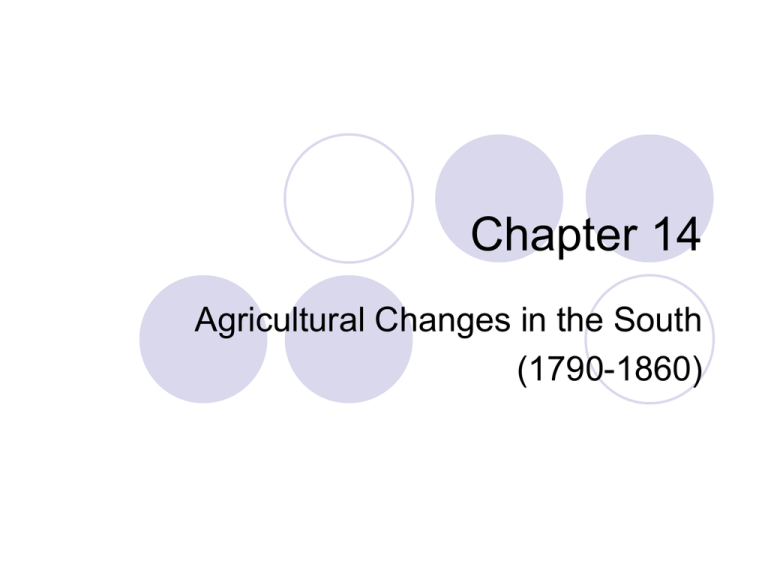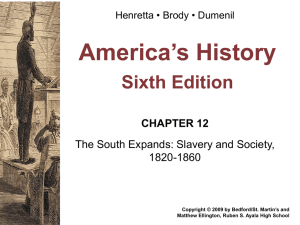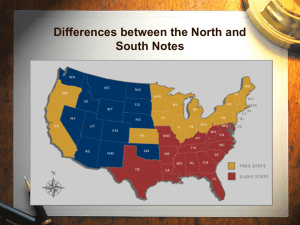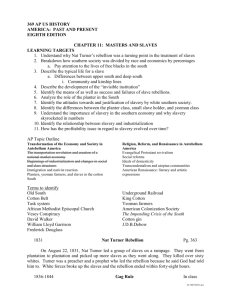Chapter 8
advertisement

Chapter 14 Agricultural Changes in the South (1790-1860) Chapter 14 Agricultural Changes in the South (1790-1860) Section 1 The Growth of Cotton The South’s Agricultural Economy Southerner’s prided themselves on their ties to the land Believed future of U.S. rested on agriculture Southern agriculture began to decline after American Revolution South’s first major cash crop = tobacco (took longer to produce) Prices for major cash crops (indigo, rice and tobacco) fell As prices fell, Upper South switched to crops that needed less labor (wheat) which led to drop in the value of slaves Some slaveholders freed slaves for moral or political reasons Northern states gradually abolished slavery completely Some planters freed slaves in their wills Leaders predicted slavery would eventually die out Whitney and the Cotton Gin Some southerners saw cotton as a cash crop that would help the economy Expanding British and American textile industries used cotton the make cloth Farmers had trouble keeping up with demand because cotton was difficult to grow and process Southerners had been growing small amounts of cotton since Jamestown was founded (1607) Preferred Long-staple (black seed) because it was easiest to process; downside = only grew in few places Short-staple (green seed) grew well, but difficult to remove seed Eli Whitney built cotton gin (1793) – used handcranked cylinder with wire teeth to pull cotton fibers apart from the seeds Visited a Georgia plantation, learned that such a machine was needed Revolutionized the cotton industry, gave new life to southern agriculture The Cotton Boom Whitney’s gin began cotton boom By 1860 southern states east of the Mississippi produced 2/3 of all U.S. cotton More than half of all American exports “Cotton Kingdom” stretched from South Carolina to Texas – became known as the cotton belt Referred to as “King Cotton” because of the importance of the cotton trade to the South’s economy Advantages of cotton as cash crop: easy grow, cost little to market, could be stored for a long time Growing and harvesting cotton required many field hands (so did sugarcane in Louisiana) planters began to use more slave labor Congress made importation of slaves into U.S. illegal in 1808 Domestic slave trade increased Chapter 14 Agricultural Changes in the South (1790-1860) Section 2 The Southern Economy The Cotton Trade Great Britain became the South’s most valuable foreign trading partner Made many believe it had turned the South into a global power Sold tons of cotton to growing textile industry in Northeast Led to growth of major port cities – Charleston, Savannah, New Orleans Crop brokers called factors managed the cotton trade Farmers sold cotton to merchants who made deals with factors Most farmers relied on navigable rivers to get product to port Shipping cotton by land was very difficult in the South Roads projects limited, south was slow to build canals, fewer miles of railroad Transportation Revolution had a wider impact in North than South Agricultural Diversity Scientific agriculture – use of scientific methods to improve farming Goals - to increase crop production and protect land used to grow cotton Crop rotation – changing the kinds of crops grown on a piece of land Many worried about South’s dependence on cotton because it wore out the soil and made the South too dependent on foreign products Common southern crops – rice, sweet potatoes, sugarcane, and wheat (London bought a lot from Alabama) Tennessee = top corn growing state by late 1830s Sugarcane became popular in Louisiana after Jean Etienne Bore (“Savior of Louisiana”) introduced new system for processing sugar – sugarcane to granulated sugar Hemp and flax became major cash crops as a result of the cotton boom Fibers used to make rope and sackcloth Southern Factories Many of first factories built to process crops Rope industry (Kentucky, Missouri, Tennessee), turning sugarcane into sugar Tredegar Iron Works (Richmond) – only large southern factory that made iron products (started by Joseph R. Anderson) One of nation’s most productive iron works Produced boilers, bridge materials, cannons, locomotives, steam engines and other products South’s industrial growth lagged behind the North Cash crops seemed to promise great wealth – most farmers invested in more land and slaves in order to grow more cotton Profits went into developing plantation system, not southern industry Chapter 14 Agricultural Changes in the South (1790-1860) Section 3 Southern Society The Planters First half of 1800s, 1/3 of white southern families had slaves Fewer had plantations Despite small numbers, planters had powerful influence over South Served as political leaders Influenced the economy Showed wealth by living in large mansions; some chose to live simply, saved all money to buy more land and slaves Male planters primarily concerned with raising crops and supervising slave laborers Running of plantation households left to wife – oversaw raising of children and work of slaves within the household Planters often arranged their children’s marriages based on business interests Southern Society and Culture Yeomen – owners of small farms Majority of southern farmers Average southern white women more likely to marry a small farmer than wealthy planter Typically held few slaves or none at all By 1860, about 80% of all southern farmers owned their own land Average farm approx. 100 acres Some earned enough to buy a few slaves; usually worked side by side with them Planters and yeomen often looked down on the landless poorest of white southerners less than 10% of white American population Lived on land not suited for growing cash crops Survived by hunting, fishing, raising animals, tending small gardens, doing odd jobs for money Southern Society and Culture Religion central to social life Farm families isolated from one another – saw neighbors only at church events Wealthy white southerners used religion to justify their position in society and the institution of slavery Set them against Northern Christians who believed God opposed slavery Writers provided look into southern society – romantic view of rural life in south Mark Twain (Samuel Clemens) – Adventures of Huckleberry Finn and Adventures of Tom Sawyer The Urban South Urban economy was influenced by plantations Southern cities like northern cities in many ways City governments built public water systems and provided well-maintained streets Public education available in some places Southern urban leaders wanted their cities to appear as modern as possible Hoped to impress foreign visitors who came to do business Slaves did much of the work in the cities Worked as domestic servants, in mills, in shipyards, and at skilled jobs Urban whites more likely to hold slaves Free African Americans In 1860 more than half of all free African Americans were living in the South – some found work in southern cities Worked in variety of jobs, mostly as skilled artisans In rural areas, they often hired out their services to plantations Churches often served as center of social life Free and enslaved African Americans started a rare independent-church movement in Charleston, SC Faced constant discrimination – many cities and states passed laws limiting the rights of free African Americans Could not vote, travel freely, or hold certain types of jobs Whites feared they would try to encourage slave rebellions Virginia (in 1806) banned former slaves from living in the state without special permission Chapter 14 Agricultural Changes in the South (1790-1860) Section 4 The Slave System Slaves and Work Most slaveholders tried to get as much work out of slaves as possible Small farms – wide variety of jobs Large plantations – assigned specific tasks Drivers made sure slaves followed orders, carried out punishments – sometimes slaves themselves Gang labor system – all hands worked on the same task at the same time, sunup to sundown Men, women and children (around age 10) did the same work Some worked as butlers, cooks or nurses in planter’s home Often better food and clothing than field hands Worked longer hours – 24 hours a day Some planters allowed slaves who worked skilled jobs on the plantation hire out their services Some earned money to buy their freedom this way Life Under Slavery Slaveholders tended to view slaves as property, not people Some bought, worked and sold to make profit Some slave traders kidnapped free African Americans to sell into slavery Slaves received poor clothing and shelter, lived in small cabins with dirt floors, leaky roofs, and few furnishings Some planters allowed slaves to keep their own vegetable gardens Some planters offered more food or better living conditions to encourage slaves’ obedience, but most used punishment Many states had strict slave codes that limited what slaves could do Prohibited from traveling far from home Teaching slaves to read or write usually illegal Slave Culture Despite harsh conditions, many took comfort in their community and culture Strong ties to one another and their heritage Family = most important unit of community Feared being separated from family more than physical punishment Passed down family histories as well as African customs and traditions Told folktales (stories with a moral) to teach lessons about how to survive under slavery Warned not to trust slaveholders Religion was important – by 1800s, many slaves = Christians Used spirituals to express religious beliefs (songs that blended African and European music) Style of worship blended aspects of traditional African religions with those of Christianity Challenging Slavery Slaves rebelled in small ways everyday Working slower to protest long hours Running away for a few days Violent slave revolts were rare but white southerners lived in fear they would occur Most violent slave revolt in the U.S. occurred in 1831 (Virginia) Nat Turner’s Rebellion – Turner believed God had called on him to end slavery Led a group of slaves that set out to kill slaveholders and their families – killed about 60 white people in the area More than 100 slaves killed in an attempt to put down the rebellion Turner caught within three weeks and executed As a result of Turner’s Rebellion, many states strengthened their slave codes







